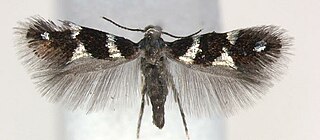
The Gelechiidae are a family of moths commonly referred to as twirler moths or gelechiid moths. They are the namesake family of the huge and little-studied superfamily Gelechioidea, and the family's taxonomy has been subject to considerable dispute. These are generally very small moths with narrow, fringed wings. The larvae of most species feed internally on various parts of their host plants, sometimes causing galls. Douglas-fir (Pseudotsuga) is a host plant common to many species of the family, particularly of the genus Chionodes, which as a result is more diverse in North America than usual for Gelechioidea.

Copromorphidae, the "tropical fruitworm moths", is a family of insects in the lepidopteran order. These moths have broad, rounded forewings, and well-camouflaged scale patterns. Unlike Carposinidae the mouthparts include "labial palps" with the second rather than third segment the longest. With other unusual structural characteristics of the caterpillar and adult, it could represent the sister lineage of all other extant members of this superfamily. The genus Sisyroxena from Madagascar is also notable for its unusual venation and wing scale sockets.

Urodidae, whose species are commonly known as false burnet moths, is a family of moths in the lepidopteran order. It is the type genus in the superfamily, Urodoidea, with three genera, one of which, Wockia, occurs in Europe.

The Heliozelidae, commonly known as shield-bearer moths, are a family of small, day flying monotrysian moths distributed worldwide. The larvae of most heliozelid species are leaf miners who cut distinctive shield-shaped cases from the surface of the host leaf, hence the common name. Some species are considered pests of commercial crops such as grapevines, cranberries, and walnuts. The taxonomy of this family is poorly understood.

Syncopacma is a genus of moths in the family Gelechiidae.

Syncopacma cinctella is a moth of the family Gelechiidae. It is found in all of Europe, Asia Minor and North Africa. In the east, the range extends through Siberia to the Russian Far East.

Anacampsinae is a subfamily of moths in the family Gelechiidae.
Sophronia teretracma is a moth of the family Gelechiidae. It was described by Edward Meyrick in 1927. It is found in North America, where it has been recorded from Texas.
Syncopacma linella is a moth of the family Gelechiidae. It was described by Pierre Chrétien in 1904. It is found in France, Austria, Slovakia, Hungary, Romania and Ukraine.

Syncopacma sangiella, the brown sober, is a moth of the family Gelechiidae. It was described by Henry Tibbats Stainton in 1863. It is found in most of Europe, except the Benelux, Denmark and parts of the Balkan Peninsula.
Syncopacma syncrita is a moth of the family Gelechiidae. It was described by Edward Meyrick in 1926. It is found in Asia Minor and India.
Syncopacma telaviviella is a moth of the family Gelechiidae. It was described by Hans Georg Amsel in 1933 and is found in Palestine.
Syncopacma ussuriella is a moth of the family Gelechiidae. It was described by Aristide Caradja in 1920. It is found in the Russian Far East.
Syncopacma adenocarpella is a moth of the family Gelechiidae. It was described by Rebel in 1927. It is found on the Canary Islands.
Syncopacma adversa is a moth of the family Gelechiidae. It was described by Annette Frances Braun in 1930. It is found in North America, where it has been recorded from California, Illinois, Kentucky, Ohio and West Virginia.
Syncopacma euprosopa is a moth of the family Gelechiidae. It was described by Edward Meyrick in 1926. It is found in Russia (Uralsk).
Syncopacma nigrella is a moth of the family Gelechiidae. It was described by Vactor Tousey Chambers in 1875. It is found in North America, where it has been recorded from Wyoming, Washington, California, Texas, Utah and Oklahoma.
Syncopacma oxyspila is a moth of the family Gelechiidae. It was described by Edward Meyrick in 1909. It is found in South Africa and Namibia.

Aproaerema palpilineella is a moth of the family Gelechiidae. It was described by Vactor Tousey Chambers in 1875. It is found in North America, where it has been recorded from Georgia, Illinois, Indiana, Kansas, Kentucky, Louisiana, Maine, Mississippi, Ohio, Oklahoma, Ontario, Quebec, Tennessee and Texas.








